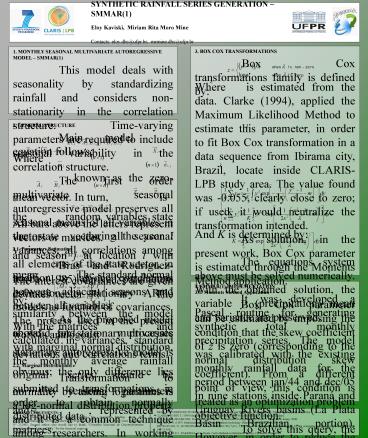Apresenta PowerPoint PPT Presentation
Title: Apresenta
1
SYNTHETIC RAINFALL SERIES GENERATION
SMMAR(1) Eloy Kaviski, Miriam Rita Moro
Mine Contacts eloy.dhs_at_ufpr.br,
mrmine.dhs_at_ufpr.br
3. BOX COX TRANSFORMATIONS Box Cox
transformations family is defined by
1. MONTHLY SEASONAL MULTIVARIATE AUTOREGRESSIVE
MODEL SMMAR(1) This model deals with
seasonality by standardizing rainfall and
considers non-stationarity in the correlation
structure. Time-varying parameters are required
to include seasonal variability in the
correlation structure. The first order
multivariate seasonal autoregressive model
preserves all seasonal means of all variables in
the state vector, all seasonal variances, all
correlations among all elements of the state
vector, in addition to lag-one correlations
between adjacent seasons and between all
variables. As the proposed model is valid for
stationary processes with marginal normal
distribution, the monthly average rainfall
original series should be submitted to
transformations, in order to obtain normally
distributed data.
Where is estimated from the data. Clarke
(1994), applied the Maximum Likelihood Method to
estimate this parameter, in order to fit Box Cox
transformation in a data sequence from Ibirama
city, Brazil, locate inside CLARIS-LPB study
area. The value found was -0.055, clearly close
to zero if used, it would neutralize the
transformation intended. As solution, in the
present work, Box Cox parameter is estimated
through the Moments Method application. 3.1.
Moments Method Application Box Cox parameter
can be estimated by imposing the condition that
the skew coefficient of z is zero (corresponding
to the normal distribution skew coefficient).
From a different point of view, this condition is
treated as an optimization problem objective
function. To solve this query, the simulated
annealing method (Lee and El-Sharkawi, 2008) is
employed. This method was devised by analogy with
the Metropolis algorithm (Metropolis et al.,
1953), which was proposed to simulate statistical
physics problems by Monte Carlo method (Newman
and Barkema, 1999). Once is calculated, the
parameters m and s, transformed variable average
and standard deviation respectively, can be
estimated using the equations
2. GENERAL STRUCTURE Main model equation follows
Where , known as the zero-mean vector. In
turn, is the random variables
state vector , during the year i and
season j at location l with mean . The
standard normal deviates vector is
. The similarity between the model above and a
multivariate stationary autoregressive model is
obvious the only difference lies on the seasonal
parameters and , represented by
matrices. SMMAR (1) get its final equation
by redefining vectors and
as and , respectively
All bars above the letters represent vectors or
matrices. 2.1. Parameters Estimation Bras and
Rodríguez-Iturbe (1985) derived parameters
estimation to stationary AR(1) models as function
of covariances. The process used in the present
work is analogous
And K is determined by
The equations system above must be solved
numerically. With the obtained solution, the
variable y (precipitation) mean and variance are
preserved.
The interest covariances are given by
4. SMMAR(1) IMPLEMENTATION It was developed a
Pascal routine for generating synthetic total
monthly precipitation series. The model was
calibrated with the existing monthly rainfall
data for the period between jan/44 and dec/05 in
nine stations inside Paraná and Uruguay Rivers
basins (La Plata Basin Brazilian portion).
However, in order to reduce the covariance
matrices sizes, principal component analysis was
applied. By reducing the matrices size,
inconsistencies occurrences in the SMMAR (1)
implementation are avoided. So, 26 groups were
determined, with dimensions ranging between 2 and
12 24 of them are smaller than 10. Depending on
the analysis performed, four SMMAR (1) versions
were prepared. All can be used to generate
synthetic total monthly precipitation series for
these stations. The proposed versions for the
model SMMAR (1) can be classified according to
the Box-Cox transformation parameter and
covariance matrices between total monthly
rainfall series (between stations for a given
month and the previous month). In summary, the
model SMMAR (1) was implemented for each month of
the year for precipitation transformed by the
logarithm and by Box-Cox transformation. Thus,
for each model it was necessary a 18 dimension
covariance matrix for each month of the year (9
rainfall stations with the precipitation of the
month and previous month). In the SMMAR (1)
calibration phase for the rainfall transformed by
Box-Cox transformation, the covariance matrices
inverses did not show inconsistencies.
With the matrices and
calculated in variances, standard deviations and
correlations terms. 2.2. Marginal
Distributions Transformation to normality by
taking logarithms is a log-normal distribution
property and it is a common technique among
researchers. In working with this marginal
distribution, one must use the proper formulation
in order to apply the parameters successfully.
Matalas (1967) brings equations that allows to
perform log-normal transformation preserving the
original variables statistics, without
bias. However, in practice, hydrological data
follows a probability distribution that is known
to be skewed but not necessarily log-normal. A
more general transformation, of which the
log-normal transformation is a particular case,
is the Box-Cox transformations family. This
technique is used in this work and is detailed
in the following.
BRAS, R. RODRÍGUEZ-ITURBE, I. (1985) Random
Functions and Hydrology. Addison-Wesley
Publishing Company, California. CLARKE, ROBIN T.
(1994) Statistical modeling in hydrology. John
Wiley Sons Ltd. Chichester, England. LEE, K.Y.,
EL-SHARKAWI, M.A. Modern Heuristic Optimization
Techniques, IEEE Press, J. Wiley, New Jersey,
2008. MATALAS, N. (1967) Mathematical assessment
of synthetic hydrology. Water Resources Res.
3(40937-46). METROPOLIS, N., ROSENBLUTH, A.W.,
ROSENBLUTH, M.N., TELLER, A.H. Equation of state
calculations by fast computing machines, J.
Chem.Phys. 21 (6), 1087 (1953). NEWMAN, M.E.J.,
BARKEMA, G.T. Monte Carlo Methods in Statistical
Physics, Clarendon Press,1999.
ACKNOWLEDGEMENTS The research leading to these
results has received funding from theEuropean
Community's Seventh Framework Programme
(FP7/2007-2013) under Grant Agreement N 212492.
Second author also would like to thank Conselho
Nacional de Desenvolvimento Científico e
Tecnológico-CNPq for the financial support.

